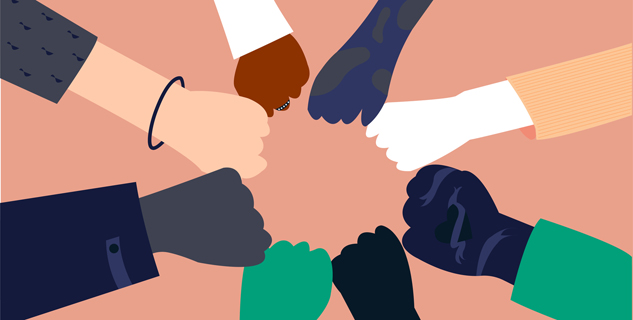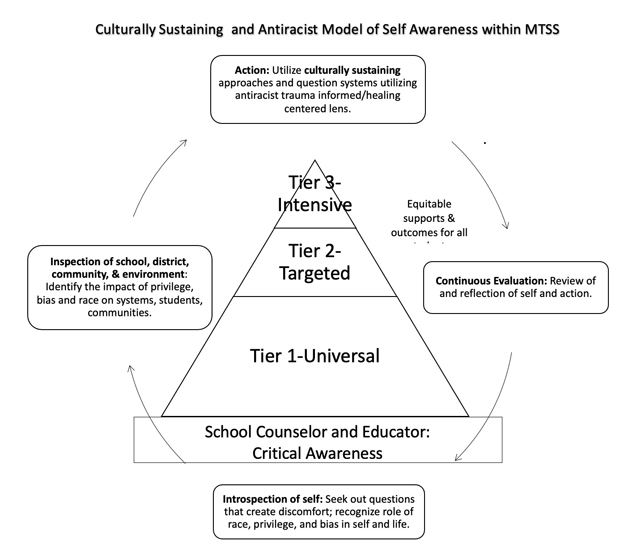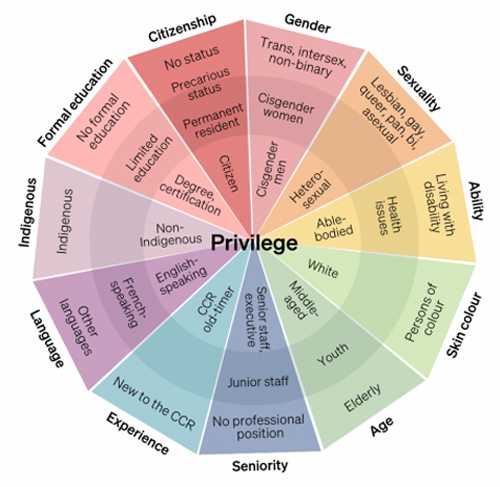
Anti-Racism Starts with Us
By Jennifer Betters-Bubon, Rebecca Pianta, Damien Sweeney, Emily Goodman-Scott | March 2024

Now more than ever, school counselors must integrate culturally sustaining and anti-racist ideals into their work. According to the ASCA position statement on anti-racist school counseling, school counselors: “engage in anti-racist actions by advocating to change racist policies, procedures, practices, guidelines and laws contributing to inequities in students’ academic, career and social/emotional development.”
Why is this important?
A 2023 study from the Centers for Disease Control reported that 42 percent of high school students reported feeling so sad or hopeless that they could not engage in their regular school activities and 22 percent had considered suicide. The data from female, LGBTQIA+ and students who experienced racism in school indicated a greater likelihood of poor mental health. Data from the U.S. Department of Education Office of Civil Rights showed that Black students tend to receive more out-of-school suspensions/expulsions and report more harassment and bullying. It’s on all of us to create systems that enhance rather than compromise youth mental health.
How can we do this?
School counselors can organize anti-racist efforts through a multitiered system of supports (MTSS), an evidence-based framework used in K-12 education. With a focus on what we do for all students (Tier 1), for some (Tier 2) and for a few (Tier 3) and on creating systems for staff, MTSS offers a structure through which school counselors can intentionally integrate anti-racist efforts.
What does this look like?
Because creating systems change can be daunting, we provide a chart of actions and activities for school counselors and educators within the MTSS framework:

Understanding privilege is crucial for school counselors because it enhances cultural proficiency and fosters empathy. Utilizing tools like the Power/Privilege Wheel (below) can aid in understanding and addressing privilege and oppression. The Power/Privilege Wheel activity guides participants in identifying their identities, understanding power dynamics and fostering dialogue to promote understanding and empathy among diverse groups. Participants in this activity first identify their various identities within the Power/Privilege Wheel, recognizing aspects where they hold privilege and where they have been marginalized. Through dialogue, they explore how to leverage their privileged identities to support marginalized groups, fostering empathy and understanding.

Data disproportionality: Look for over- or under-representation of a specific group in any category, program or service, including but not limited to:
Throughout, being a data-driven school counselor is key, with recognition that being data driven doesn’t mean looking solely at numbers. Providing stakeholders with data and listening to their feedback and ideas honors their voices and gives you even more data to positively impact your program and school community.
For instance, as the MTSS team collects data on school trends (e.g., disproportionate honors course enrollment or absenteeism), we must consider how we can bring that data in front of groups of students, families and community members for their feedback. What is the root cause of this disproportionality? What changes need to happen in our systems: school, class, policy/procedures? This may mean looking for new locations outside of the school building to meet with these constituents, such as local community libraries or a space in a local apartment or community center.
In her recent Professional School Counseling article, Dr. Krystal Clemons discussed MTSS school counselor collaboration with Black/African American communities by getting out into the community, such as churches, barbershops, Black Greek letter organizations and other central community gatherings. School/family community liaisons in schools may be able to assist in determining the best location.
Resources
Jennifer Betters-Bubon, Ph.D., is an associate professor at the University of Wisconsin–Whitewater. Rebecca Pianta, Ed.D., is coordinator of College and Career Readiness, with Santa Ana Unified School District. Damien Sweeney, Ed.D., is the Director of Diversity, Equity, Inclusion and Belonging at the Kentucky Department of Education. Emily Goodman-Scott, Ph.D., is an associate professor at Old Dominion University in Norfolk, VA.
Why is this important?
A 2023 study from the Centers for Disease Control reported that 42 percent of high school students reported feeling so sad or hopeless that they could not engage in their regular school activities and 22 percent had considered suicide. The data from female, LGBTQIA+ and students who experienced racism in school indicated a greater likelihood of poor mental health. Data from the U.S. Department of Education Office of Civil Rights showed that Black students tend to receive more out-of-school suspensions/expulsions and report more harassment and bullying. It’s on all of us to create systems that enhance rather than compromise youth mental health.
How can we do this?
School counselors can organize anti-racist efforts through a multitiered system of supports (MTSS), an evidence-based framework used in K-12 education. With a focus on what we do for all students (Tier 1), for some (Tier 2) and for a few (Tier 3) and on creating systems for staff, MTSS offers a structure through which school counselors can intentionally integrate anti-racist efforts.
What does this look like?
Because creating systems change can be daunting, we provide a chart of actions and activities for school counselors and educators within the MTSS framework:

Step 1: Introspection of Self
Our approach begins with an introspection of self. School counselors who are co-creating systems must engage in self-examination, which includes addressing both explicit and implicit biases, to safeguard students from harm. School counselors can employ various strategies to assess and neutralize their biases. Utilizing tools like the Harvard Implicit Association Test (IAT) can offer insight into one’s implicit biases. And actively challenging stereotypes and seeking out diverse perspectives through engaging with individuals from various backgrounds and cultures can serve to broaden perceptions. It’s critical to engage in continuous education and professional learning to deepen one's understanding of biases.Understanding privilege is crucial for school counselors because it enhances cultural proficiency and fosters empathy. Utilizing tools like the Power/Privilege Wheel (below) can aid in understanding and addressing privilege and oppression. The Power/Privilege Wheel activity guides participants in identifying their identities, understanding power dynamics and fostering dialogue to promote understanding and empathy among diverse groups. Participants in this activity first identify their various identities within the Power/Privilege Wheel, recognizing aspects where they hold privilege and where they have been marginalized. Through dialogue, they explore how to leverage their privileged identities to support marginalized groups, fostering empathy and understanding.

Step 2: Inspection of School/District/Community
With knowledge of self, school counselors and a larger school team examine whether all students have access and support through a schoolwide equity audit that examines:Data disproportionality: Look for over- or under-representation of a specific group in any category, program or service, including but not limited to:
- Discipline
- Advanced/gifted programming
- Special education
- Chronic absenteeism
- Course passing, course failures and/or non-promotion
- Postsecondary enrollment
- Extracurricular activities
- Family conferences/engagement
Throughout, being a data-driven school counselor is key, with recognition that being data driven doesn’t mean looking solely at numbers. Providing stakeholders with data and listening to their feedback and ideas honors their voices and gives you even more data to positively impact your program and school community.
Step 3 and 4: Action and Reflection
As we are reflecting internally on our own journey and intentionally looking at data in our school and district, being an antiracist advocate includes (a) centering the voices of students, families and community members, and (b) ensuring we are making changes at the systems level. In her book “School Counseling to Close the Opportunity Gap,” Dr. Cheryl Holcomb-McCoy wrote, “Nothing for us, without us. We move to action, working alongside students, families, and communities.”For instance, as the MTSS team collects data on school trends (e.g., disproportionate honors course enrollment or absenteeism), we must consider how we can bring that data in front of groups of students, families and community members for their feedback. What is the root cause of this disproportionality? What changes need to happen in our systems: school, class, policy/procedures? This may mean looking for new locations outside of the school building to meet with these constituents, such as local community libraries or a space in a local apartment or community center.
In her recent Professional School Counseling article, Dr. Krystal Clemons discussed MTSS school counselor collaboration with Black/African American communities by getting out into the community, such as churches, barbershops, Black Greek letter organizations and other central community gatherings. School/family community liaisons in schools may be able to assist in determining the best location.
Final Thoughts
Please know that any time we try something different (e.g., centering student/family/community voices in different ways, systemic change, meeting in new spaces), this will likely require extra advocacy and work, especially at first. If you receive pushback from school leadership for trying something new, please don’t lose heart. Know that resistance is part of the advocacy and systemic change process. In the end, we must upload our ethical standards, engaging in reflection, inspection and action to ensure our systems are culturally sustaining and antiracist so that all students can thrive.Resources
- Classroom WISE: Cultural Inclusiveness and Equity WISE Resources:
- Discipline Disproportionality Problem Solving: A Data Guide for School Teams
- Harvard Implicit Bias Test
- Street data: A next-generation model for equity, pedagogy, and school transformation, 2021, by S. Safir & J. Dugan
Jennifer Betters-Bubon, Ph.D., is an associate professor at the University of Wisconsin–Whitewater. Rebecca Pianta, Ed.D., is coordinator of College and Career Readiness, with Santa Ana Unified School District. Damien Sweeney, Ed.D., is the Director of Diversity, Equity, Inclusion and Belonging at the Kentucky Department of Education. Emily Goodman-Scott, Ph.D., is an associate professor at Old Dominion University in Norfolk, VA.